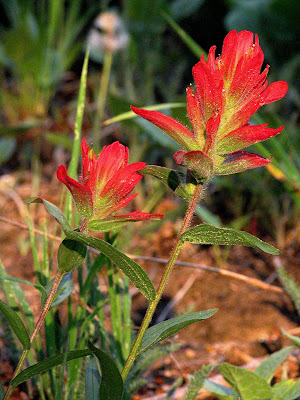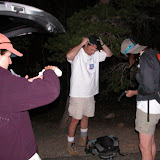Beef Basin spread open like a book in the early morning light. The higher buttes lit up even more orange than usual, while the sage flats still retained a hint of inky blackness. A bit of chill still hung in the desert air. Numerous canyons feed onto the flats and choosing one to explore was as simple as following your feet. I had read that this place held promise for ruins and I was here searching for the Anasazi. After dinner, the night before, in the fading light I slowly walked around my campsite and began to find pottery shards; white with black woven designs, pinched, some colorless, and some quite large. I knew this place would indeed be special.
At just over 6000 feet this is high desert - the sun rays hot, boiling the summer and in winter the air bare and chilling. There was no one else here and no soul within at least 50 miles - maybe more. I was alone and I could experience this place through silence and solitude, much as those that lived did over 800 years ago. When the Anasazi last lived in these bright canyons Genghis Khan was marauding across the steppes of Mongolia, Europe was in the dark ages, and most men still lived not unlike the Anasazi, perhaps worse.
The Anasazi are not an ethnicity so much as a culture. We identify their building and their artifacts, but we know little about the people. Their disappearance during the 13th century is one of the great mysteries of American history and archeology. Their habitations go back for over 500 years and then vanish as they near the middle ages. There are many theories, but no agreement as to why.
 One of the least understood facts for those who have not been to the Colorado Plateau is how expansive the ruins are. Everywhere I've been there are ruins. It is as if their civilization created a mighty extended city for hundreds and hundreds of miles. They seemingly lived everywhere and inhabited every corner. But, equally, one must understand that the Anasazi abandoned their settlements moving on to different lands; sometimes moving back into a place that had been left hundreds of years before, following the water and the desert shapes that tied them to their unknown mythology.
One of the least understood facts for those who have not been to the Colorado Plateau is how expansive the ruins are. Everywhere I've been there are ruins. It is as if their civilization created a mighty extended city for hundreds and hundreds of miles. They seemingly lived everywhere and inhabited every corner. But, equally, one must understand that the Anasazi abandoned their settlements moving on to different lands; sometimes moving back into a place that had been left hundreds of years before, following the water and the desert shapes that tied them to their unknown mythology.
The Abajo mountains, to the south and east of Beef Basin, are the supposed location of some of the last remnants of the Anasazi. Whatever forced them to scatter brought them to this place. Where I was the canyon opens up into beef basin there is a small stream and a small ruin. It looks small and poorly built, but of extreme age. The streams in this country are mere dribbles appearing and disappearing - dependent upon the depth of the sand overlying the bedrock. This dribble ran into Beef Basin for about 50 yards and disappeared beneath the sage in a grassy green final breath.
 One of the reasons I was here was to discover the water and how far I might wander in the future. Did the intermittent springs shown on the maps flow? How much country could I cover in one day? I knew how much I needed - about 3 liters during the day (or about 100 oz). The temperatures climbed to about 100 during the heat of the day with the ground temperatures being about 120. I wore a long-sleeved desert shirt, a wide brimmed hat and shorts and could climb and travel quickly throughout the greater part of the day mostly unaffected by the heat.
One of the reasons I was here was to discover the water and how far I might wander in the future. Did the intermittent springs shown on the maps flow? How much country could I cover in one day? I knew how much I needed - about 3 liters during the day (or about 100 oz). The temperatures climbed to about 100 during the heat of the day with the ground temperatures being about 120. I wore a long-sleeved desert shirt, a wide brimmed hat and shorts and could climb and travel quickly throughout the greater part of the day mostly unaffected by the heat.
I believe my bones remember my youth. I was born into this world in the Mojave Desert and as a young boy played out in the heat in one of the hottest places in the continent. And, although I never fully connected the dots until recently, I have always loved the heat - a hot car, the full rays of the hot sun, or now; the baked quality of the desert at noon.
The canyon was neither deep nor wide, surrounded on each side by small, rough and broken sandstone cliffs varying between 20 and 60 feet capped by a gradually rising plateau on which grew pinion pine, juniper, and low-growing sage, but on which mostly plain, dry and cracked white clay soil lies giving way in places to swaths of loose sand. Sometimes, this upper plateau was capped by solid sandstone mounds, steeply sided, and devoid of vegetation, rising hundreds of feet above the pinion pine. The stream came and went in patches of green, life swirling around the nectar then ending in the dust and the heat.
What I had sought surprised me stopping me in my tracks, but it was far away and I was unsure of what I saw. I was accustomed to seeing cliff dwellings, but to see a tower rising out of the pinion was new to me. I raised my glasses and in excitement started in a run.
The canyon forked; the west side of the west fork was broken down, the cliff disappearing into a steep slope. At that place about 80 feet above the floor of the canyon stood an ancient tower. I approached, not up the obvious slope, but from small, deep "V" cut, directly to the north. I wanted to be secret, to surprise the stones, to walk up not as a tourist, but as a user.
The tower was not a single tower, but the tallest remaining tower left in a habitation of about 20 similar structures. What remained was about two stories tall and completely circular with a diameter of about 14 feet gradually decreasing in diameter going up at an angle of about 4 or 5 degrees. Each other structure was built against each other structure, not unlike mud dabber nests. To get into any one you had to travel through several low doorways. The construction was not tight and mortared, but well fit and loose. At one time the entire inside was plastered - small finger prints were visible still pressed into the dried mud; however, most of this covering had long since worn away. Two square structures occupied part of the small, flat area. I assumed them to be older, but partially rebuilt at some point.
I could see the Anasazi, baked by the sun, small of stature, rough-hewed, and smiling walking down to the intermittent stream, pot in hand - ducking out of the coolness of the narrow doorways, sitting on the same stone upon which I now sat. I saw what they saw. Looking up and down the canyon I wondered.
I spent some time in this quiet place and at last I squatted in the shadow of the tower collecting my pack and drinking in the coolness before I stepped back into the heat. I scanned the loose earth around me - shards here and there, juniper seeds - some black with age and some still deep purple. Something smooth, something different caught my eye, a glint of a brilliant white thin edge. I moved the dirt aside with my finger and a polished shell with a hole in the center came into view. It was about half the size of the tip of my small finger - 2 or 3 cm wide, tiny, thin, convex, and finely crafted. It was easy to see that is was once worn as part of a necklace. Perhaps with purple juniper berries and quills; perhaps with other beads and stones. I did not know, but it was lost over 800 years ago and now found its way into my hand!
I wondered if its end was violent, or accidental. Was it torn away or lovingly sought after? Did it represent love? Was its ending written in blood?
I was on BLM land and sites such as this are routinely robbed. I knew I had to take the bead, but I didn't know where. I put it in a tiny pocket on my upper sleeve seemly reserved for such small items. I carried it throughout what would become a magical day - a day the Anasazi mystified and delighted me - a day I walked in their shadow. My footprints that day, the smell, and the sun are driven into my memory; indelible and enduring, until I too go the way of the Anasazi.
Several days later I returned to Moab. Having been to the NPS HQ there to collect a permit for going into Salt Creek Canyon - a canyon full of cliff dwellings, I knew its location. I asked for the chief archaeologist and was soon shown into a small office with maps and file drawers scattered around the room. I showed her my treasure and she was quite surprised. I got a good scolding for removing the object, but I explained it wasn't located in the park, but in BLM land. She couldn't accept the treasure, but directed me to the BLM office.
Again, I found the Chief Archaeologist. This time, however, I did not get a cold greeting. She was thrilled I saved the bead and I gave her the exact coordinates of its final resting place. She carefully wrote down the information and copied my map. Before leaving I asked her to tell me what she knew about it.
She said it was a very special find because the bead was from an olivella shell. She explained, archaeologists often infer paths of past culture contact by sourcing artifacts. Marine shells have been used as indicators of culture contact across long distances. Modern geographical ranges of marine mollusks are virtually identical to the ranges that occurred in the recent past, and this allows archaeologists to determine the coast of origin of sea-shell artifacts recovered from inland sites. Unless there is evidence that the geographic range of an animal has changed, we can safely assume that current ranges are the same as those in the past. This shell was traded across the west from the coast of modern California! Rather all at once, or over time, no one can tell, but either way a fact not missed by the imagination. Goods were flowing back and forth across great distances 400 years before Europeans discovered the "new world" and I had held some of those goods and took it on perhaps its last journey.
I will go back to the Basin. I could spend an entire summer there, in the heat, wandering the canyons, climbing the cliffs, and searching for the soul of the past. The vastness and beauty filling my being with the unknown and the unknowable.















































